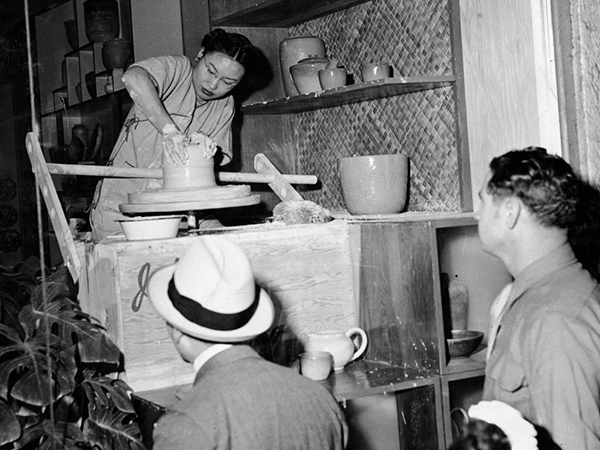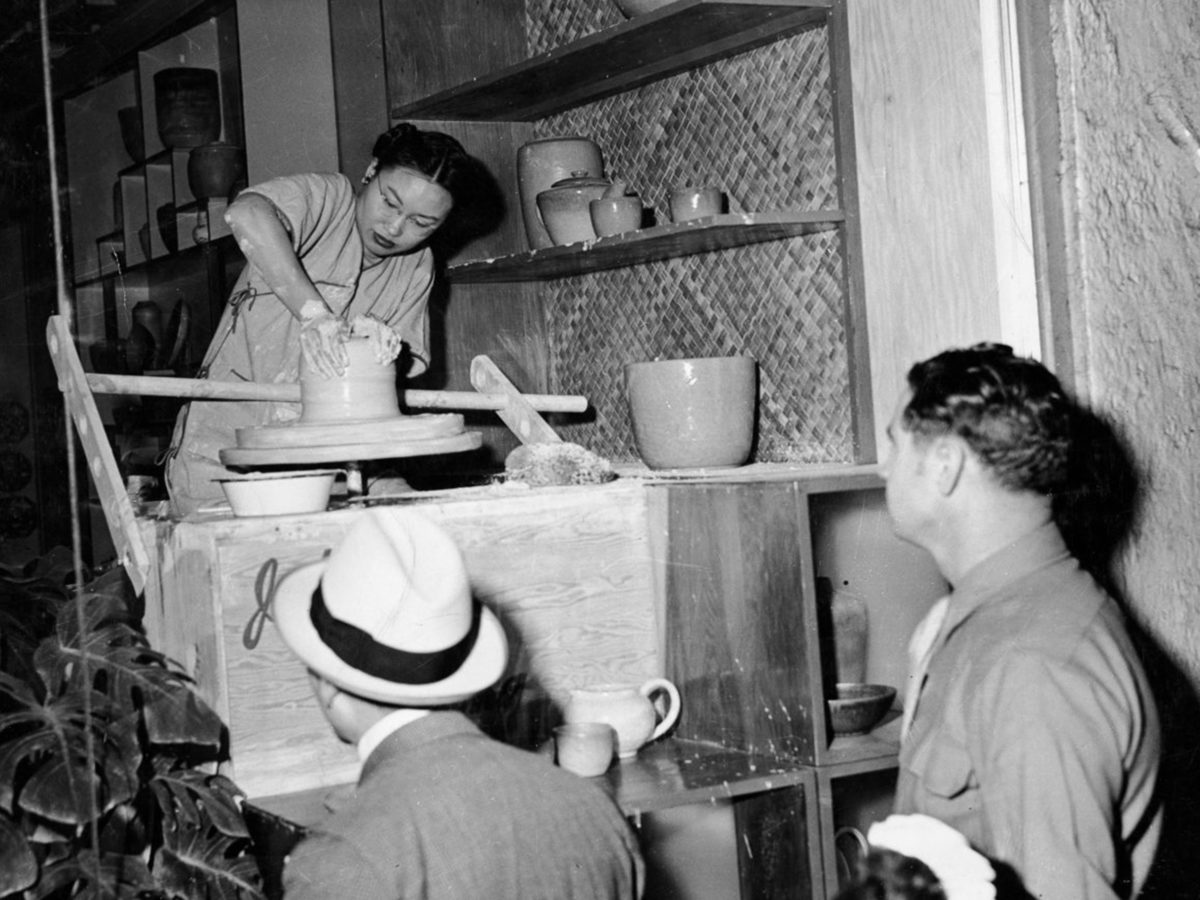Activity
Jade Snow Wong: Crafting a Chinese American Identity
Lesson: Watch and discuss the film "Jade Snow Wong" to understand the cultural conflicts experienced by Chinese American women during the 1930s and 1940s and how similar tensions still exist today.

Jade Snow Wong
Common Core Standards
ELA & Literacy
6.L.2: Interpret information presented in diverse media and formats (e.g. visually, quantitatively, orally) and explain how it contributes to a topic, text, or issue under study.
6-12.SL.1: Engage effectively in a range of collaborative discussions (one-on-one, in groups, and teacher-led) with diverse partners on grade appropriate topics and texts, building on others’ ideas and expressing their own clearly and persuasively.
7.SL.3: Delineate a speaker’s argument and specific claims, and attitude toward the subject, evaluating the soundness of the reasoning and the relevance and sufficiency of the evidence.
9-10.RI.7: Analyze various accounts of a subject told in different mediums (e.g., a person’s life story in both print and multimedia), determining which details are emphasized in each account.
6-8.10: Write routinely over extended time frames (time for reflection and revision) and shorter time frames (a single sitting or a day or two) for a range of discipline-specific tasks, purposes, and audiences.
History-Social Science
1.4: Students compare and contrast everyday life in different times and places around the world and recognize that some aspects of people, places, and things change over time while others stay the same.
2.5: Students understand the importance of individual action and character and explain how the heroes from long ago and the recent past have made a difference in others’ lives.
11.11: Students analyze the major social problems and domestic policy issues in contemporary American society.
Materials
“Jade Snow Wong” (1977, 30 minutes, accessible online at https://vimeo.com/126857095)
Activity
Watching the Film
- Before watching the film….
- Acknowledge that the film is a product of its time (1970s) and that it doesn’t tell Wong’s complete story — her work as an artist, cultural ambassador, and civic leader is left out. The focus is on Wong’s upbringing in San Francisco’s Chinatown and her struggle to reconcile her father’s strict Confucian teachings and traditional views on gender with her desire to be “American.” If students are unfamiliar with Confucian teachings, teachers may want to give an overview first before students watch the film. (A possible resource: https://asiasociety.org/education/confucianism.)
- Students might benefit from an overview of the major U.S. immigration laws that shaped the Wong family’s experience. You can use the following timeline to give a general sense of how Chinese immigrants were viewed by the U.S. government in the late 19th and early 20th centuries: http://bancroft.berkeley.edu/collections/chinese-immigration-to-the-united-states-1884-1944/timeline.html
-
While watching the film….
As students watch the film, they should be jotting down notes on what they find interesting, confusing, upsetting, or even funny.
-
After watching the film….
Expanding on their notes from the viewing, students journal-write for 10 to 15 minutes on their reaction to the film. Ask the students to be specific — which scenes/moments in the film spurred this reaction in them?
If there is time, have the students pair-share on their journal-writes using the following guiding questions:
- What did your responses have in common; what was different?
- How is Jade Snow Wong’s story still relevant today? (This question helps the students to move beyond their own reactions.)
In-Depth Discussion: You can divide the students into small groups and assign each group a topic on which they’ll share out later or you can stay together as a large group. The following are possible prompts, organized by topic:
Treatment of Chinese Americans in 1930s and 1940s
- Why was Jade Snow’s father unable to become an American citizen during her childhood? (May need to give background on the Chinese Exclusion Act of 1882 as well as other immigration restrictions of the time.)
- Recall the speeches given at the ship christening. Why was it significant that Jade Snow won this honor? (How did her honor come to reflect that of all Chinese Americans?) Why did mainstream Americans change their attitude toward the Chinese and Chinese Americans during this time? (May need to give background on the bombing of Pearl Harbor and Japanese internment.)
- How is Chinatown depicted in this film? How did Chinatown shape Jade Snow’s upbringing and views on life? (For further discussion: How is San Francisco’s Chinatown different today? If not in San Francisco, how is Chinatown viewed in your city?)
- How might the scapegoating of different Asian groups in America throughout the 20th century resonate with certain immigrant groups today?
Confucianism and Chinese Family Structure/Relationships
- What expectations did Jade Snow’s father have for her and her siblings? Give specific examples of his hopes/dreams/fears for his children.
- How did Mr. Wong teach his children?
- How did birth order impact the way the children were treated?
- How did Jade Snow’s father react when she rebelled against his authority? What was his perspective — can you sympathize with his concerns?
- How did the Milligan family behave with each other? (Share specific examples.) How do you think Jade Snow felt witnessing these interactions?
Gender Issues
- Why was Jade Snow’s position in her family especially “low”? Give specific moments/quotes that illustrate the restrictions and expectations placed upon her.
- How did Jade Snow’s mother behave throughout the film? What did we see her doing? When did she speak (for the first and only time)? (One last note: Why wasn’t she able to attend Jade Snow’s graduation?)
- What kind of jobs did we see Jade Snow do in the film? (Cooking, cleaning, ironing, typing.) Why is it significant that she eventually became an artist?
- How did Jade Snow’s male friend treat her? How was their behavior relatively “progressive” for their time? How might that behavior be viewed in the 1970s, when this film was made? How does their behavior look to you today?
- What aspects of the gender roles depicted in the film still exist today?
The Immigrant Experience / The American Dream
- What kind of work did the Wong family do? What was their family schedule/routine?
- Did Mr. Wong plan on staying in America? Why not? Does this make his adherence to Chinese values and traditions more understandable? Why was Jade Snow’s father so concerned with how the Chinatown community viewed him and his family?
- Which of Jade Snow’s experiences show that she was always seen as “Chinese” and not “American”? (fight with her father over dating, kind but condescending treatment by Milligans)
- How does the film’s ending suggest that the Wong family achieved the “American Dream”? (Might need to first discuss what the “American Dream” means.)
- How does Jade Snow Wong’s story, as depicted in the film, illustrate the pros and cons of assimilation? (Might need to define “assimilation” first.)
The Film as a Historical Artifact/Document
- What was the purpose or agenda of this film? (What did it focus on? What did it leave out?) For which audience was this film meant?
- How “factual” do you think this film was? How does the film promote intercultural understanding? At the same time, does it reinforce any stereotypes about Chinese women or families?
- What does the film tell you about the time in which it was made (the 1970s)? How might the film be different if it were made today?
Connecting to Jade Snow Wong’s Career as an Artist
The following quotes from Wong’s introductory essay to the book “Jade Snow Wong: A Retrospective” describe her efforts to establish her art career by doing pottery in the window of Chinatown storefront. Contemplating these quotes might further the class discussion on how Wong viewed being “American”:
“From the time I stepped into the window, I attracted crowds. I sold enough pottery to the general American public to convince that my style was acceptable. However, the Chinese community and my mother were not enthusiastic. With perpetually muddy hands, I had forsaken the 2500-year-old Confucian ideal of the scholar who studied to avoid getting his hands dirty.” (18) [*see note below]
“I did not step into the window to be a ‘pioneer.’ I felt it was the option which would enable me, almost sixty years ago, to be free of the Chinese culture’s subjugation of women, while I would also avoid being boxed into twin American obstacles of prejudice against women in the corporate world, and against Chinese economically, legally, and socially. (I found no prejudice against me in art or in writing.)” (21)
“[My husband and I] were both renegades against illogical tradition while American values supported individual creativity.” (22)
How accurate is Wong’s assertion that American values support “individual creativity”? How is her story one of both rebellion and conformity?
*Ironically, Jade Snow Wong could be seen as embodying the Confucian ideal — she was a modern female version of the literati: a scholar-artist-poet who also served the government (in Wong’s case, as a cultural ambassador).
Additional Resource
Kingston, Maxine Hong et al. “Jade Snow Wong: A Retrospective.” San Francisco: Chinese Historical Society of America, 2002.
Evaluation Options
- Journal Write on one of the following topics:
- Can you relate to Jade Snow Wong’s story? If so, what episodes and conflicts resonated with you? What did you take away from watching this video?
- Did any scenes in the video introduce you to something new or shed light on something you didn’t understand before? Explain.
- If you couldn’t connect to Wong’s story, what made her experience seem too different from yours? What made it hard for you to relate to her story?
- Possible Formal Assessments:
- Write an essay analyzing the ending scenes of the “Jade Snow Wong” film (from 22:46 on). What messages is the film trying to convey about how Chinese Americans could feel accepted into mid-20th-century American society? How are the messages similar/different for immigrants today?
- Write an essay analyzing the different “layers of time” that shape the audience’s response to this film. While the story actually takes place in the 1930s–40s, the film was made in the late 1970s, after the Civil Rights era. How might the timing of the film’s production have affected how Wong’s story was told? How do our current 21st-century sensibilities affect our viewing of the film today? Is it possible to ever get an “uncurated” look at the past?
- Near the end of the film, the narrator mentions a change in immigration laws that made it possible for Wong’s father to become an American citizen. Research and write a paper on the 19th- and 20th-century immigration laws that shaped the Wong family’s experience in the U.S.
For more lessons based on Jade Snow Wong, visit the artist’s teacher packet.





